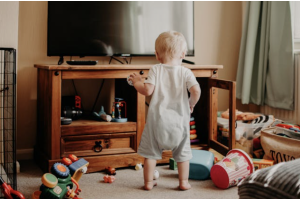Practical Ways To Make Your Home Safer For Kids

Creating a safe environment for children is a fundamental concern for all parents and caregivers. With their natural curiosity and inclination to explore, kids can often find hazards in seemingly innocuous places. This underscores the importance of taking proactive measures to ensure that your home is a safe haven. Implementing safety measures protects children from accidents and fosters peace of mind for parents, allowing them to focus on nurturing and enjoying their time with their little ones.
Understanding Risks in the Home
To lift the veil on child safety, it is key first to understand the potential risks present in your home. Common household items can pose serious dangers to children if not managed properly. These include sharp objects like knives, toxic substances found in cleaning supplies, and choking hazards such as small toys or coins. Statistics indicate that more than 2.5 million children suffer injuries in the home every year in the United States alone, highlighting the need for increased awareness about household safety.
Furnishings and decor can be latent dangers. Heavy furniture can tip over if not anchored, and window cords can pose strangulation risks. Being vigilant about your surroundings and identifying potential hazards is the first crucial step toward creating a safer living environment.
Securing Hazardous Areas
Securing areas in the home that are prone to accidents is crucial. Start with the kitchen, where sharp knives, hot appliances, and toxic cleaning supplies can be just out of reach. Ensure that all hazardous items are stored in locked cabinets or on higher shelves. Magnetic locks or childproof latches are effective solutions for keeping curious hands at bay.
The bathroom is another critical area for child safety. Medications, razors, and cleaning products should be stored securely. Installing non-slip mats helps prevent falls and creates safe pathways when the floors are wet. Regularly reminding children about the dangers of playing unsupervised in these areas can further bolster safety.
Creating Safe Play Spaces
Designating safe play areas for children can significantly reduce the chances of accidents. Ensure that toys are age-appropriate and free from choking hazards, and look for items that are sturdy enough to withstand the rough-and-tumble play typical of young children. Consider using a designated room or corner of the home where play can occur under supervision.
In outdoor spaces, fences should be installed to protect children from nearby streets or hazards. Play equipment like swings and slides need to be set up on soft surfaces like mulch or grass to cushion falls. If your home requires renovations, you might find budget-friendly options such as a cheap flooring store, which can provide child-friendly flooring solutions without breaking the bank. Taking these steps creates a safer environment and gives caregivers greater confidence during children’s playtime.
Childproofing Items
Childproofing is the process of making your home safer through simple adjustments. Outlet covers, corner guards, and cabinet locks play a significant role in preventing injuries. These items are generally inexpensive yet effective in eliminating many common risks. Outlet covers are particularly vital, as children are often drawn to sockets, and these have been shown to prevent electrical shocks.
Another area to focus on is the modification of furniture. Heavy items should be anchored to the wall to avoid tipping tall bookshelves and dressers. Securing televisions on low stands can prevent accidents. By anticipating children’s movements and instinctively curious behaviors, parents can craft an environment that is less likely to lead to injury.
Educating Children About Safety
While it is crucial to implement physical safety measures, educating children about safety is equally important. Engage children in conversations about potential dangers, such as the importance of not opening doors to strangers or knowing how to call for help during emergencies. Teaching them to identify harmful substances and sharp objects can empower them to keep themselves safe.
Role-playing with children can reinforce safety lessons, allowing them to practice what to do in certain situations. Make safety discussions a part of everyday life so that children understand the significance of safety in various contexts. This proactive approach nurtures a sense of responsibility in children from an early age.
Monitoring and Supervision
Ongoing supervision is one of the most effective ways to ensure children’s safety at home. Regularly monitor their behavior during playtime to intervene if they engage in unsafe activities. Keep an eye on things that can change quickly, such as other children visiting or new toys that may not be safe.
Establishing rules about how and where children can play can create a structured environment that is conducive to safety. Designate areas for different types of play, quiet playtime in the living room, and more vigorous outdoor play in the backyard. This method of organization reinforces safety and instills in children guidelines to follow as they mature. Always being present and aware protects children and strengthens family bonds as you engage in shared activities.
Emergency Preparedness
Preparing for emergencies is crucial. Every household should have a plan in case of fires, severe weather, and other emergencies. Involve your children in safety drills so they are aware of what to do in case something unexpected occurs. Educating them about the responsibilities of calling emergency services can save lives.
Keeping a well-stocked first aid kit readily accessible and updating it regularly is important for treating minor injuries quickly. Knowledge of basic first aid can provide peace of mind and enable a prompt response in case of accidents. Involving your children in the preparation process can teach them the importance of safety and readiness.
In working toward a safer home for children, the combination of preventive measures, education, and active monitoring creates a comprehensive approach to safety. Understanding the risks, securing hazardous items, and fostering an environment where children can learn about safety measures prepares them to be more aware and responsible as they grow. These practices don't just safeguard kids. They provide parents with the reassurance that they are doing their part to reduce dangers in their home.






